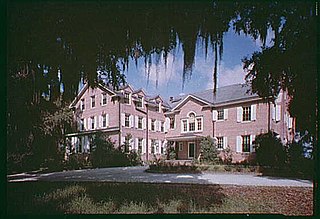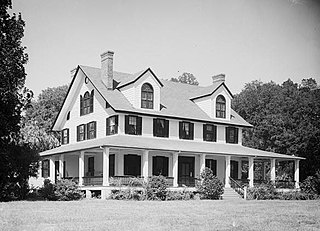
Georgetown County is a county located in the U.S. state of South Carolina. As of the 2020 census, the population was 63,404. Its county seat is Georgetown. The county was founded in 1769. It is named for George III of the United Kingdom.

Bluffton is a town in southern Beaufort County, South Carolina, United States. The population as of the 2020 census was 27,716, an increase of over 120% since 2010, making it one of the fastest growing municipalities in South Carolina. Bluffton is the fifth largest municipality in South Carolina by land area. It is primarily located around U.S. Route 278, between Hilton Head Island and Interstate 95. The Lowcountry town's original one square mile area, now known as Old Town, is situated on a bluff along the May River. Bluffton is a primary town within the Hilton Head Island-Bluffton-Port Royal, SC Metropolitan Statistical Area.

Georgetown is the third oldest city in the U.S. state of South Carolina and the county seat of Georgetown County, in the Lowcountry. As of the 2010 census it had a population of 9,163. Located on Winyah Bay at the confluence of the Black, Great Pee Dee, Waccamaw, and Sampit rivers, Georgetown is the second largest seaport in South Carolina, handling over 960,000 tons of materials a year, while Charleston is the largest.

Mansfield Plantation is a well-preserved antebellum rice plantation, established in 1718 on the banks of the Black River in historic Georgetown County, South Carolina.

Hobcaw Barony is a 16,000-acre (6,475 ha) tract on a peninsula called Waccamaw Neck between the Winyah Bay and the Atlantic Ocean in Georgetown County, South Carolina. Much of Hobcaw Barony is south of US Highway 17. The land was purchased by the investor, philanthropist, presidential advisor, and South Carolina native Bernard M. Baruch between 1905 and 1907 for a winter hunting retreat. Later, his eldest child, Belle W. Baruch, began purchasing the property from her father beginning in 1936. By 1956, Belle owned Hobcaw Barony entirely. Upon her death in 1964, the property was transferred to the Belle W. Baruch Foundation for a nature and research preserve. The property includes more than 37 historic buildings and structures representative of the eras of both 18th & 19th century rice cultivation and 20th century winter retreats. Hobcaw Barony was named to the National Register of Historic Places on November 2, 1994.

Peter Horry was an American planter who served as an officer in the southern theater of the American Revolutionary War. He served under the command of Francis Marion, waging a guerilla war against the British and Loyalist forces. Peter Horry was elected to public office, served in the state militia, and oversaw a controversial history of Marion.

All Saints Church Pawleys Island is a historic church complex and national historic district located on Pawleys Island, Georgetown County, South Carolina. The district encompasses three contributing buildings and one contributing site—the sanctuary, cemetery, rectory, and chapel. In 2004, it left the Episcopal Church to join the Diocese of the Carolinas, now part of the Anglican Church in North America, a denomination within the Anglican realignment movement.

The Chicora Wood Plantation is a former rice plantation in Georgetown County, South Carolina. The plantation itself was established sometime between 1732 and 1736 and the 1819 plantation house still exists today. In 1827, Robert Francis Withers Allston (1801–1864) resigned as surveyor-general of South Carolina to take over full-time management of Chicora Wood, which he had inherited from his father. Chicora Wood served as a home base for his network of rice plantations, which produced 840,000 pounds of rice in 1850 and 1,500,000 pounds by 1860. 401 slaves worked the plantation in 1850, increasing to 630 by 1860.

Battery White was an artillery battery constructed by the Confederates during the American Civil War. Built in 1862–63 to defend Winyah Bay on the South Carolina coast, the battery was strongly situated and constructed; however, it was inadequately manned, and was captured without resistance during the final months of the war.

Annandale Plantation, originally known as Millbrook, is a historic plantation house located near Georgetown, in Georgetown County, South Carolina.
Keithfield Plantation is a historic rice plantation property and national historic district located near Georgetown, Georgetown County, South Carolina. The district encompasses 1 contributing building, 1 contributing site, and 3 contributing structures. They include a slave cabin, built about 1830, and agricultural features including examples of historic ricefields, canals, dikes, and trunks. The original main house burned in the mid-20th century. Keithfield was one of several productive rice plantations on the Black River.
Milldam Rice Mill and Rice Barn, also known as Kinloch Plantation, is a historic rice plantation property and national historic district located near Georgetown, Georgetown County, South Carolina. The district encompasses 1 contributing building, 1 contributing site, and 3 contributing structures. This rice mill and rice barn are associated with Milldam, one of several productive rice plantations on the Santee River. Agricultural features include examples of historic ricefields, including canals, dikes and trunks. The Rice Barn was destroyed by Hurricane Hugo in 1989.
Nightingale Hall Rice Mill Chimney, also known as Nightingale Plantation, is a historic rice mill chimney located near Georgetown, Georgetown County, South Carolina. This rice mill chimney is significant as one of seven known extant rice mill chimneys in Georgetown County. It is associated with Nightingale Hall, one of several productive plantations on the Pee Dee River. The chimney is approximately 29 feet high, and 6 feet square at the base.

Pee Dee River Rice Planters Historic District is a set of historic rice plantation properties and national historic district located near Georgetown, Georgetown County, South Carolina.
Fairfield Rice Mill Chimney is a historic rice mill chimney located near Georgetown, Georgetown County, South Carolina. It is one of seven known extant rice mill chimneys in Georgetown County. It was associated with Fairfield, one of several productive plantations on the Waccamaw River.
Weehaw Rice Mill Chimney is a historic rice mill chimney located near Georgetown, Georgetown County, South Carolina. This rice mill chimney is significant as one of seven known extant rice mill chimneys in Georgetown County. It is associated with Weehaw, on the Black River, which was one of the earliest successful rice plantations in the area. The chimney is approximately 35 feet high.

Georgetown Historic District is a national historic district located at Georgetown, Georgetown County, South Carolina. The district encompasses 49 contributing buildings in the central business district of Georgetown. The oldest existing structure in Georgetown is a dwelling which dates from about 1737. There are approximately 28 additional 18th century structures as well as 18 buildings erected during the 19th century prior to the American Civil War. The existing structures—homes, churches, public buildings—are of both historical and architectural significance and are situated on heavily shaded, wide streets. The architecture ranges from the simplicity of early colonial, or Georgian, to the elaborate rice plantation era, such as Classical Revival. Notable buildings include the Georgetown County Courthouse, U.S. Post Office, The Rice Museum, Winyah Indigo Society Hall, Masonic Lodge, Antipedo Baptist Church Cemetery, Prince George Winyah Episcopal Church complex, St. Mary's Catholic Church, Kaminski Building, Mary Man House, Dr. Charles Fyffe / Middleton House, John Cleland / Allston House, Samuel Sampson / Henning-Ward House, Robert Stewart / George Pawley House, Martha Allston Pyatt /John S. Pyatt House, Eleazar Waterman / Withers House, and William Waties / Withers House.
Murrells Inlet Historic District is a national historic district located at Murrells Inlet, Georgetown County, South Carolina. The district encompasses 37 contributing buildings and contains a significant concentration of buildings that visually reflect the transition of the area from adjoining estates of two 19th-century rice planters into a 20th-century resort community. The district contains two antebellum houses, which are local interpretations of the Greek Revival style and a collection of early-20th-century vernacular resort buildings. Residential in character, the historic district contains approximately 19 houses. Although they exhibit some diversity, the prevalent use of wood as a building material, the large screened porches, and the setting of moss-draped trees, marshland, and piers provide a visual unity.

Pawleys Island Historic District is a national historic district located at Pawleys Island, Georgetown County, South Carolina. The district encompasses 12 contributing buildings and contains buildings ranging from ca. 1780 to post World War I, and includes shoreline which the owners of these homes think they own, and marshland. The building style is a variation of West Indian architecture which has been adapted to Pawleys climatic conditions. The original houses on Pawleys are not mansions but summer retreats, sturdily built and large enough to accommodate big families. Designed for the greatest degree of ventilation, with porches on multiple sides and with high brick foundations providing protection against gale tides, many of the 20th-century buildings have adhered to the traditional design that has proven well suited to this environment. The houses are equipped with large chimneys and fireplaces. Breezeways attached at the rear of the houses led to the kitchens. Servant's quarters were usually one or two room cabins equipped with fireplaces.
















